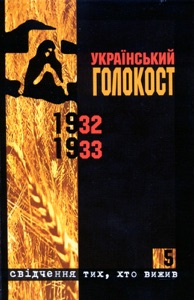










This book, in Ukrainian, contains testimonies of Ukrainian Famine-Holodomor victims and witnesses, stored in the archives of the UCRDC. It was published in Ukraine by the Kyiv-Mohyla Academy Publishing House as the fifth volume of the series Ukrainskyi Holokost 1932-3, edited by Rev. Dr. Yuri Mycyk, Professor of History at the Kyiv-Mohyla Academy. The fifth volume is the result of an agreement of cooperation between Dr. Mycyk and Iroida Wynnyckyj, the archivist of the UCRDC.
Of the 48 transcribed testimonies, 22 were taped in 1982-1984 as part of the preparation of the UCRDC film Harvest of Despair. These testimonies can be put into three categories: of those who lived through the famine and describe their personal experiences; of foreigners – diplomats, journalists, etc – witnesses of the famine; and, thirdly, of inhabitants of Western Ukraine who were living outside the borders of Soviet Ukraine and tried to send aid. Twenty-six of the testimonies included in the book are from interviews done from 1985 to 2007.
The testimonies in the collection reflect the efforts of the diaspora to preserve memories of the famine and explain this tragedy to the western world. Ms.Wynnyckyi explained: “In making the selection for this volume, an effort was made to choose those testimonies which deal with facts that help to demonstrate the famine as genocide against the Ukrainian nation and not merely to prove that a famine took place. Particular attention is paid to testimonies that speak of the confiscation of food and the taking away of the means of livelihood from the peasants, the brutal conduct of the officials towards the population, proof that collective farm workers were also dying from hunger, the role of the ‘torgsins’ (where valuables could be exchanged for bread), instances of the resistance of the peasantry, and proof that there was no famine in Moscow or other Russian cities as people tried to go there to barter for food but were prevented from doing so.”
The testimonies recorded are those of people who were adults during the famine and some of whom held positions of authority. The testimonies of the foreigners - diplomats such as Hans von Herwarth, an attaché at the German embassy in Moscow, or Ulrich Hencke, the German consul in Kyiv – provide a unique perspective and shine light on the politics of the Soviet regime at the time. The witnesses from Western Ukraine, for example Metropolitan Mstyslav (Skrypnyk), describe the cruel refusals to accept any aid for the famine-stricken population of Soviet Ukraine.

-
‣Home

